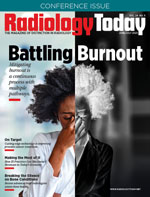 Editor’s Note: ’Tis the Season
Editor’s Note: ’Tis the Season
By David Yeager
Radiology Today
Vol. 24 No. 5 P. 5
Summer is here, and conference season is upon us. The Society for Imaging Informatics in Medicine (SIIM), SNMMI, and AHRA all have conferences in June and July. Whatever your preferences are, you will likely find something that catches your interest. Radiology Today will be checking in on SIIM and SNMMI remotely, but we’ll be in person at AHRA. If you happen to be at the show, stop by booth 110 and say hi.
For this month’s cover feature, Claudia Stahl examines burnout. A session at the annual Society of Interventional Radiology (SIR) meeting in March discussed various aspects of burnout and some specific ways that it affects women. Burnout among female physicians may be as high as 60% greater than among male physicians. The costs of reduced productivity and higher physician turnover are eye opening, and that’s without factoring in the effect it can have on patient care. Radiology typically ranks in the top 10 physician specialties for burnout, so mitigating the root causes can go a long way toward creating a better work environment, which will almost certainly translate to improved care.
Another session from the SIR meeting looked at the economics of running an IR practice. Beth W. Orenstein speaks with some of the presenters, who offer their tips for maintaining a thriving practice. Among the takeaways: Embrace direct patient care, offer a variety of procedures, stay on top of coding changes that affect reimbursement, and document everything. For more details, turn to page 22.
In clinical news, Keith Loria has a prostate cancer update. Much progress has been made in the past decade on agents that image prostate cancer more effectively. An exciting new trend is the development of theranostic agents that can not only detect but also treat prostate cancer. In addition, AI-enhanced imaging technology is providing clearer views of the disease. The future looks bright for prostate cancer imaging and treatment.
A clinical issue that is less easily discovered is bone disease. Rebecca Montz delves into this frequently overlooked issue. More than one in eight people worldwide have musculoskeletal conditions, a number that is likely to rise as the world’s population ages. Diseases such as osteoporosis pose a particular challenge because, often, the first sign of the disease is a fracture. The Office of the Surgeon General estimates that 1.5 million people in the United States will suffer a fracture due to a bone disease this year, with osteoporosis being the leading cause. Existing tools and advancing technology are helping to identify bone diseases sooner, so proactive measures can be taken.
Enjoy the issue.
— Dave Yeager
david.yeager@gvpub.com
